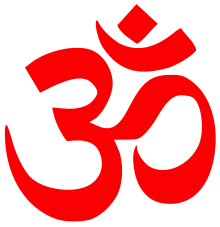Om

Om ose Omkar-i (Auṃ, shkruar sipas Devanāgari: ॐ ose ओम्, në Sanskritisht: प्रणव , Auṃkāra ose Aumkāra) ओंकार), sipas filozofisë indiane, është materia që është krijuar nga tingulli, dhe OM-i është tingulli më i shenjtë, rrokja qe i parapriu universit dhe lindi perënditë. Piktograma përfaqeson trinitetin hindu, e shkuara, e tashmja dhe e ardhmja.
Thuhet ndryshe se është thelbi i Absolutit suprem, [1] ndërgjegjes, [2] [3] [4] Ātman , Brahman , ose botës kozmike. [5] [6] Rrokja gjendet shpesh në fillim dhe në fund të kapitujve në Vedat, Upanishadëve dhe tekste të tjera hindu . [7]
Om u shfaq (gesi) në korpusin Vedik dhe thuhet se është një formë e kapsuluar e këngëve ose himneve samavedike . [8] [9] Është një magjepsje e shenjtë shpirtërore e bërë para dhe gjatë recitimit të teksteve shpirtërore, gjatë puxhave dhe lutjeve private, në ceremonitë e riteve të kalimit ( samskara ) si dasmat, dhe gjatë aktiviteteve medituese dhe shpirtërore si Pranava yoga . [10] [11] Është pjesë e ikonografisë së gjetur në dorëshkrimet e epokës së lashtë dhe mesjetare, tempujt, manastiret dhe vendstrehimet shpirtërore në hinduizëm, budizëm, xhainizëm dhe sikizëm . [12] [13] Si rrokje, ajo shpesh këndohet ose në mënyrë të pavarur ose para një recitimi shpirtëror dhe gjatë meditimit në hinduizëm, budizëm dhe xhainizëm . [14] [15]

Referime
[Redakto | Redakto nëpërmjet kodit]- ^ Beck, Guy L. (2012). Sonic liturgy: ritual and music in Hindu tradition. Columbia: University of South Carolina Press. fq. 25. ISBN 978-1-61117-108-2. OCLC 824698506.
((cite book)): Mungon ose është bosh parametri|language=(Ndihmë!) - ^ James Lochtefeld (2002), "Om", The Illustrated Encyclopedia of Hinduism, Vol. 2: N-Z, Rosen Publishing. ISBN 978-0823931804, page 482
- ^ Holdrege, Barbara A. (1996). Veda and Torah: Transcending the Textuality of Scripture. SUNY Press. fq. 57. ISBN 978-0-7914-1640-2.
((cite book)): Mungon ose është bosh parametri|language=(Ndihmë!) - ^ "Om". Merriam-Webster (2013), Pronounced: \ˈōm\
- ^ David Leeming (2005), The Oxford Companion to World Mythology, Oxford University Press, ISBN 978-0195156690, page 54
- ^ Hajime Nakamura, A History of Early Vedānta Philosophy, Part 2, Motilal Banarsidass, ISBN 978-8120819634, page 318
- ^ Annette Wilke and Oliver Moebus (2011), Sound and Communication: An Aesthetic Cultural History of Sanskrit Hinduism, De Gruyter, ISBN 978-3110181593, pages 435–456
- ^ Gerety, Moore (2015-05-20). This Whole World Is OM: Song, Soteriology, and the Emergence of the Sacred Syllable (Tezë). Harvard University, Graduate School of Arts & Sciences.
((cite thesis)): Mungon ose është bosh parametri|language=(Ndihmë!) - ^ Jones, Constance; Ryan, James D. (2006). Encyclopedia of Hinduism (në anglisht). Infobase Publishing. fq. 319–20. ISBN 978-0-8160-7564-5.
- ^ David White (2011), Yoga in Practice, Princeton University Press, ISBN 978-0691140865, pp. 104–111
- ^ Alexander Studholme (2012), The Origins of Om Manipadme Hum: A Study of the Karandavyuha Sutra, State University of New York Press, ISBN 978-0791453902, pages 1–4
- ^ T. A. Gopinatha Rao (1993), Elements of Hindu Iconography, Volume 2, Motilal Banarsidass, ISBN 978-8120808775, p. 248
- ^ Sehdev Kumar (2001), A Thousand Petalled Lotus: Jain Temples of Rajasthan, ISBN 978-8170173489, p. 5
- ^ Jan Gonda (1963), The Indian Mantra, Oriens, Vol. 16, pp. 244–297
- ^ Julius Lipner (2010), Hindus: Their Religious Beliefs and Practices, Routledge, ISBN 978-0415456760, pp. 66–67
Text is available under the CC BY-SA 4.0 license; additional terms may apply.
Images, videos and audio are available under their respective licenses.
